Undeciphered writing systems
Many undeciphered writing systems exist today; most date back several thousand years, although some more modern examples do exist. The term "writing systems" is used here loosely to refer to groups of glyphs which appear to have representational symbolic meaning, but which may include "systems" that are largely artistic in nature and are thus not examples of actual writing.

.jpg.webp)
The difficulty in deciphering these systems can arise from a lack of known language descendants or from the languages being entirely isolated, from insufficient examples of text having been found and even (such as in the case of Vinča) from the question of whether the symbols actually constitute a writing system at all. Some researchers have claimed to be able to decipher certain writing systems, such as those of Epi-Olmec, Phaistos and Indus texts; but to date, these claims have not been widely accepted within the scientific community, or confirmed by independent researchers, for the writing systems listed here (unless otherwise specified).
Proto-writing
Certain forms of proto-writing remain undeciphered and, because of a lack of evidence and linguistic descendants, it is quite likely that they will never be deciphered.
Neolithic signs in China
- Jiahu symbols – Peiligang culture, from China, c. 6600 – 6200 BC.
- Damaidi symbols – Damaidi, from China, earliest estimated dates range from Paleolithic to c. 3000 years ago
- Dadiwan symbols – Dadiwan, from China, c. 5800 – 5400 BC.
- Banpo symbols – Yangshao culture, from China, 5th millennium BC.
- Jiangzhai symbols – Yangshao culture, from China, 4th millennium BC.
- Dawenkou symbols – Dawenkou culture, c. 2800 – 2500 BC.
- Longshan symbols – Longshan culture, from China, c. 2500 – 1900 BC.
- Wucheng symbols – Wucheng culture, from China, c. 1600 BC
Other areas
 Jiahu symbols
Jiahu symbols Banpo symbols
Banpo symbols Longshan symbols
Longshan symbols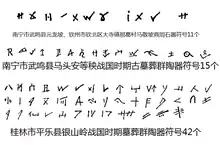 Sawveh
Sawveh
Neolithic signs in Europe
- Dispilio Tablet – Neolithic Europe, from Greece, c. 5202 BC.
- Vinča symbols – Neolithic Europe, from Central Europe and Southeastern Europe, c. 4500 BC – 4000 BC.
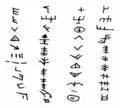 Dispilio tablet
Dispilio tablet Vinča symbols
Vinča symbols
Afro-Eurasian scripts
Indian subcontinent
- Indus script, c. 3500 BC to 1900 BC.
- Vikramkhol inscription, c. 1500 BC
- Megalithic graffiti symbols, c. 1000 BC - 300 AD, possible writing system and possible descendant of Indus script
- Pushkarasari script – Gandhara, 3rd century BC to 8th century AD.
- Shankhalipi, c. 4th to 8th century
 Indus script
Indus script Vikramkhol inscription
Vikramkhol inscription Pushkarasari script
Pushkarasari script Shankhalipi
Shankhalipi
West Asia
- Proto-Elamite script, c. 3200 BC
- Jiroft script, c. 2200 BC
- Wadi el-Ħôl script, c. 1800 BC, likely an abjad.
- Byblos syllabary – the city of Byblos, c. 1700 BC
- Cypro-Minoan syllabary, c. 1550 BC
- Eteocypriot, c. 10th century BC, written in the deciphered Cypriot syllabary but the language itself is undeciphered.
 Proto-Elamite script
Proto-Elamite script Wadi el-Hol script
Wadi el-Hol script Byblos syllabry
Byblos syllabry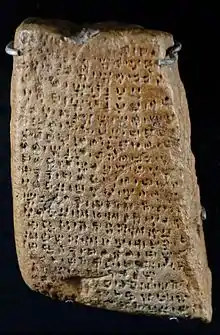 Cypro-Minoan syllabry
Cypro-Minoan syllabry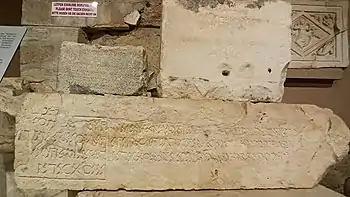 Sidetic script
Sidetic script
East Asia
- Ba–Shu scripts, 5th to 4th century BC.
- Khitan large script and Khitan small script – Khitan, 10th century, not fully deciphered.
- Tujia script
 Ba script
Ba script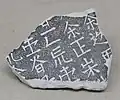 Khitan large script
Khitan large script Khitan small script
Khitan small script Tujia script
Tujia script
Southeast Asia
- Singapore Stone, a fragment of a sandstone slab inscribed with an ancient Southeast Asian script, perhaps Old Javanese or Sanskrit. At least 13th century, and possibly as early as 10th to 11th century
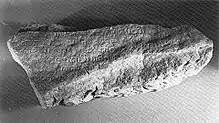 Singapore Stone
Singapore Stone
Central Asia
- Oxus script, c. 2200 BC
- Issyk inscription, Kazakhstan, c. 4th century BC
- Kushan script, c. 2nd century BC - 7th century AD, partially deciphered.
 Issyk inscription
Issyk inscription
Europe
- Cretan hieroglyphs, c. 2100 BC.
- Linear A and Cretan hieroglyphs are both believed to be an example of the Minoan language. Several words have been decoded from the scripts, but no definite conclusions on the meanings of the words have been made.
- Phaistos Disc, c. 2000 BC.
- Linear A, c. 1800 BC, a syllabary
- Grakliani Hill script - Grakliani Hill, c. 11th - 10th century BC
- Paleohispanic scripts
- Southwest Paleohispanic script, from c. 700 BC
- Eteocretan, c. 7th - 3rd century BC, written in the Greek script but language is undeciphered, likely related to Minoan.
- Sitovo inscription
- Alekanovo inscription, c. 10th - 11th century
- Rohonc Codex
- Folio 7r-v of British Library manuscript MS 73525, pre-1550, possibly liturgical.[1]
- Voynich manuscript, carbon dated to the 15th century.[2]
- Some scholars consider the corpus of Pictish symbol stones to be an undeciphered writing system[3]
 Cretan hieroglyphs
Cretan hieroglyphs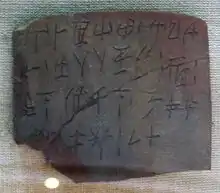 Linear A
Linear A Phaistos disc
Phaistos disc.png.webp) Southwest Paleohispanic Script
Southwest Paleohispanic Script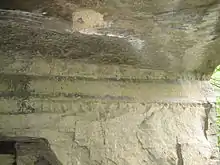 Sitovo inscription
Sitovo inscription Folio 7r of MS 73525
Folio 7r of MS 73525 Folio 7v of MS 73525
Folio 7v of MS 73525
North Africa
- The Starving of Saqqara - possibly dating to pre-dynastic Egypt
- Numidian language (although the script, Libyco-Berber, has been almost fully deciphered, the language has not)
- Meroitic language, c. 300 BC to 400 AD, though the Meroitic script is largely deciphered, the underlying language is not.
- Ṣǝḥuf ʾǝmni inscription (although written in the well-known South Arabian script, the language has not yet been identified)
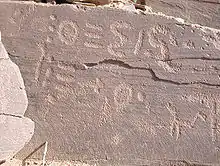 Libyco-Berber
Libyco-Berber Meroitic script
Meroitic script
Sub-Saharan Africa
- Eghap script – Cameroon, c. 1900, partially deciphered.
- Ancient inscriptions in Somalia, According to the Ministry of Information and National Guidance of Somalia, inscriptions can be found on various old Taalo Tiiriyaad structures. These are enormous stone mounds found especially in northeastern Somalia. Among the main sites where these Taalo are located are Xabaalo Ambiyad in Alula District, Baar Madhere in Beledweyne District, and Harti Yimid in Las Anod District.[4]
American scripts
Andean South America
- Khipu – Inka Empire and predecessor states, like the Wari Empire or the Caral-Supe Civilization, c. 2600 BC - 18th century, with some variants still in use today; it could possibly be a writing system or a set of writing systems.
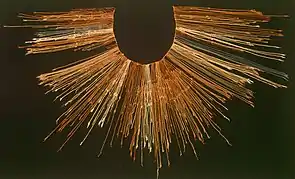 Khipu
Khipu
Mesoamerica
- Olmec – Olmec civilization, c. 600 BC, possibly the oldest Mesoamerican script.
- Epi-olmec, c. 400 BC–500 AD, apparently logosyllabic.
- Izapan script, Late Preclassic - possibly logosyllabic. Guatemalan and Chiapas Pacific Coast. Probably an offshoot of Epi-olmec.
- Zapotec – Zapotec. Possibly logosyllabic, c. 500 BC–700 AD.
- Ñuiñe script- Late Classic. Similar to and possibly an offshoot of Zapotec in the Mixteca Baja
- Teotihuacan. Possibly descended from the Zapotec script, and itself being the probable ancestor of the Post-classic Mixtec and Aztec scripts, c. 100 BC - 700 AD. Possibly a logosyllabary
- Mixtec – Mixtec, 12th–14th century, the pictographic elements which accompany the script are well-understood, but semantic and linguistic components of the script proper are less well known. The glyphs proper which accompany the pictographs are logosyllabic.
Virtually all Mesoamerican Glyphic Scripts remain undeciphered, with the only exceptions being the Maya Script and the Aztec Script.
There were other scripts in several areas of Postclassic Mesoamerica descended from the Teotihuacan script and siblings of the Aztec and Mixtec scripts, but they are very poorly attested in some colonial period codices.
 Isthmian script
Isthmian script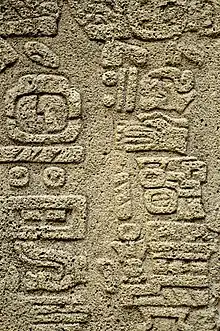 Zapotec script
Zapotec script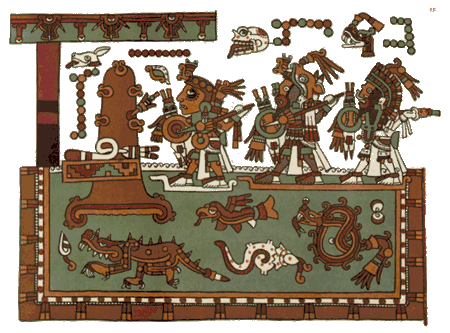 Mixtec Script
Mixtec Script
Related concepts: texts that are not writing systems
One very similar concept is that of false writing systems, which appear to be writing but are not. False writing cannot be deciphered because it has no semantic meaning. These particularly include asemic writing created for artistic purposes. One prominent example is the Codex Seraphinianus.
Another similar concept is that of undeciphered cryptograms, or cipher messages. These are not writing systems per se, but a disguised form of another text. Of course any cryptogram is intended to be undecipherable by anyone except the intended recipient so vast numbers of these exist, but a few examples have become famous and are listed in list of ciphertexts.
References
- "MS 73525". British Library. Retrieved 20 June 2023.
- "Mysterious Voynich manuscript is genuine, scientists find". Archived from the original on 2009-12-07. Retrieved 2009-12-07.
- Lee, Rob; Jonathan, Philip; Ziman, Pauline (2010-09-08). "Pictish symbols revealed as a written language through application of Shannon entropy". Proceedings of the Royal Society A: Mathematical, Physical and Engineering Sciences. 466 (2121): 2545–2560. Bibcode:2010RSPSA.466.2545L. doi:10.1098/rspa.2010.0041. ISSN 1364-5021.
- Ministry of Information and National Guidance, Somalia, The writing of the Somali language: A Great Landmark in Our Revolutionary History, (Ministry of Information and National Guidance: 1974)
_edit1.jpg.webp)